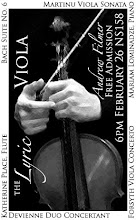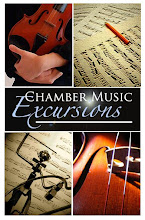This is a collection of images I plan to use for my lecture on scordatura at the Royal Northern College of Music in Manchester, titled "Angels, Devils, and the Mistuned Instrument: The Past, Present, and Future of Scordatura".
I figured this may be a way around some connection issues in uploading directly to Prezi.
1. "Tuning is too mainstream."
It was probably a joke, but it really does describe scordatura.
It was probably a joke, but it really does describe scordatura.
2. Cross Tuning
The Biber sonatas are alternatively called the "Mystery" or "Rosary" sonatas - both are correct, being part of the longer title Sonatas on the Mysteries of the Rosary. Some say the resonances have some symbolic gesture - the Resurrection Sonata has additional, visual symbolism.
The Biber sonatas are alternatively called the "Mystery" or "Rosary" sonatas - both are correct, being part of the longer title Sonatas on the Mysteries of the Rosary. Some say the resonances have some symbolic gesture - the Resurrection Sonata has additional, visual symbolism.
3. Diabolus in musica
Since the devil stopped playing the bagpipes around the end of the medieval period, the violin has been his preferred instrument of choice… The demonic tritone falls on the sixth semitone above (and below) the tonic as opposed to the perfect fifth. – Janet K. Halfyard
Six being the Devil's number – with scordatura used by Mahler and Saint-Saëns to depict the Devil as a fiddler, playing to a band of witches.
4. Post-Tonal Scordatura
The use of scordatura in a post-tonal context comes in various forms. Larry Polansky decided to utilize only natural harmonics, and tune instruments to produce them fitting just intonation, rather than even-tempered tuning. A guide was constructed for the player, to know how each harmonic would veer from what one would expect.
The use of scordatura in a post-tonal context comes in various forms. Larry Polansky decided to utilize only natural harmonics, and tune instruments to produce them fitting just intonation, rather than even-tempered tuning. A guide was constructed for the player, to know how each harmonic would veer from what one would expect.
The use of "dynamic scordatura" - the movement of a string in the middle of a performance, rather than preparing a tuning in advance, seen here in Suesse's Luft.
5. Resonant Frequencies
My research extends the use of scordatura in calibrating tuning to resonant frequencies of instruments.
Everyone has heard of a singer shattering a glass with a
note to which the glass naturally resonated; the circumstances must be most
unusual, or trumpet players would cause a lot of damage. – Sir James Beaument
Basically one looks for the frequencies in which an object - in this case a musical instrument - vibrates best. From xkcd by Randall Munroe:
This has led to a model of scordatura, which will be published in String Praxis in the next week or so:
I do believe that having a model is useful in itself, but I couldn't help but note what Dilbert would say:















No comments:
Post a Comment